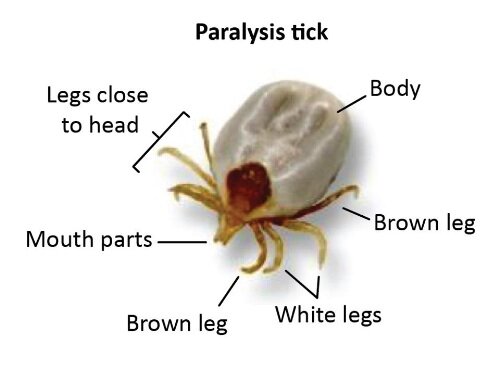Paralysis Ticks
Here on the Gold Coast, it is tick season all year-round. We usually see more cases in late spring or early summer, especially after rain, but ticks can be a year-round health threat to our fur babies here.
The Australian Paralysis Tick, Ixodes holocyclus, is found in the bushy coastal regions of Eastern Australian and is a parasite most likely to affect native mammals, livestock and pets. Though sometimes even humans can become affected.
Paralysis ticks can attach on any area of your pet; however, they are more likely to attach on the front half of your pet. The tick’s saliva contains toxins that cause muscle weakness which then leads to paralysis. The tick usually needs to feed for 1-2 days before symptoms appear. Paralysis usually starts in the hind limbs and then moves up the body which can then affect the animal’s ability to breath, but paralysis can occur in any part of the body at any time.
Common symptoms of tick paralysis:
- incoordination
- weakness especially in the back legs
- Inability to stand or walk
- Vomiting/retching
- Change of bark or meow
- Difficulty breathing
If ticks are attached close to the eyes, they can cause the eyelids to stop blinking which could dry out the eyes causing damage. Another thing to be aware of is the toxin also affects the animal’s ability to swallow which could predispose them to pneumonia. Tick paralysis is progressive and potentially fatal and should be treated as soon as the animal shows symptoms of tick paralysis. The longer that the pet is without treatment the harder it is to treat the paralysis. If you find a tick on your pet pull it off straight away and call us so that we can discuss identification of the tick and assessment and treatment if needed.
If your pet isn’t showing signs of tick paralysis then treatment won’t be started immediately, but we will discuss with you what you need to monitor for, as your pet can still develop signs or get worse even once the tick is removed. Occasionally they get worse for days after a tick is removed. Of course, if there is one tick, there could be another one so don’t stop searching them!
The good news is this disease is totally preventable!
Clipping your dog or cats coat short, especially during tick season, makes performing tick searches much easier.
We highly recommend using Bravecto, Simparica or Nexgard in Dogs to prevent paralysis ticks and fleas and we are super excited that Bravecto and Revolution Plus are now available for our feline friends to keep them safe too.
Please call the clinic on (07) 5502 3686 or pop into the clinic to find out more information about paralysis tick identification, prevention and treatment.
Partially Engorged Paralysis Tick
Fully Engorged Paralysis Tick



